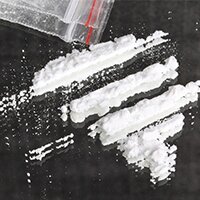- Nasal Damage
- Sudden Weight Loss
- Aggression/Violent Behavior
- Teeth Grinding
- Psychosis
- Intense Euphoria and Energy
- Presence of Keys with Powder Residue
- Sources
What are Bath Salts?
Bath salts are designer drugs that are typically advertised as “legal highs” and labeled “not for human consumption” in order to avoid legal ramifications and sidestep drug classification laws.
Bath salts belong to the family of drugs called synthetic cathinones, which elicit profound stimulant effects when used. These harmful drugs should not be confused with Epsom salts, which are used for baths.

Bath salts are especially dangerous since they aren’t regulated and are relatively cheap to buy.
These drugs have similar effects to that of cocaine, MDMA, and methamphetamine. These synthetic cathinones are typically used in a binge-pattern, with many doses taken over a long period of time (about 9 hours or so) and oftentimes with other drugs.
Therapists are Standing By to Treat Your Depression, Anxiety or Other Mental Health Needs
Explore Your Options Today
If you’re concerned that someone you know is using bath salts, there are a number of signs and symptoms of abuse outlined below:
Nasal Damage
Bath salts are often taken intranasally. Snorting drugs can cause a number of visible, negative effects on the nasal membranes. The most common nasal effects are:
- Perforated nasal septum.
- Sinusitis.
- Bleeding nose.
The above symptoms could be a result of bath salts abuse or addiction and are reason for concern.
Sudden Weight Loss
Aggression/Violent Behavior
Aggression is a common adverse effect associated with bath salts intoxication. If your loved one exhibits violent behavior unusual to him or her, there is a chance he or she has been using bath salts.
It’s important to note that you shouldn’t approach your loved one if he or she is in a violent and unpredictable state as it could be dangerous for you. Call 911 if you believe you or your loved one is in danger.
Teeth Grinding
Someone who is under the influence of bath salts is likely to experience teeth grinding or a clenched jaw, also known as bruxism. It is a typical side effect of stimulant use and may lead to tooth damage and cracking.
Psychosis
Users commonly report experiencing paranoia, auditory and visual hallucinations, and delusions after having used bath salts.
- They become disconnected with reality and exhibit erratic behavior.
- Psychosis or psychosis-type symptoms, not better explained by a mental health disorder, is a major sign of bath salts abuse.
Intense Euphoria and Energy
 Don’t wait
Find a treatment program that will help your loved one overcome the adverse effects of bath salts.
Bath salts hijack the pathways of the brain that are concerned with reward and cause the user to feel intense euphoria or happiness.
Don’t wait
Find a treatment program that will help your loved one overcome the adverse effects of bath salts.
Bath salts hijack the pathways of the brain that are concerned with reward and cause the user to feel intense euphoria or happiness.
- Since bath salts elicit amphetamine-like effects, the individual under the influence will typically have an unusual amount of energy.
- These are two tell-tale signs of bath salts abuse and should not be ignored.
Presence of Keys with Powder Residue
The most common route of administration for bath salts is nasal insufflation .
- Many bath salts users will dip a key in the powder form of the drug and snort it.
- This is called “keying” and a gram of bath salts will supply a user with anywhere from 5 to 8 “keys”.
If your loved one has loose keys lying around with a white powder residue on them, he or she may be abusing bath salts and could be at-risk for many different harmful effects.
Sources
- Drugs of Abuse: 2015 Edition. (2015). Retrieved December 3, 2015, from http://www.dea.gov/pr/multimedia-library/publications/drug_of_abuse.pdf
- Prosser, J., & Nelson, L. (2012, March 1). The Toxicology of Bath Salts: A Review of Synthetic Cathinones. Retrieved October 14, 2015, from http://www.ncbi.nlm.nih.gov/pmc/articles/PMC3550219/
- John, M. (n.d.). Overview and Treatment of Bath Salts Intoxication and Opioid Withdrawal. Retrieved December 3, 2015, from http://mha.ohio.gov/portals/0/assets/initiatives/public-private/updatedpresentationaddictionconference.pdf
- German, C., Fleckenstein, A., & Hanson, G. (n.d.). Bath salts and synthetic cathinones: An emerging designer drug phenomenon. Life Sciences, 97(1), 2-8. doi:10.1016/j.lfs.2013.07.023